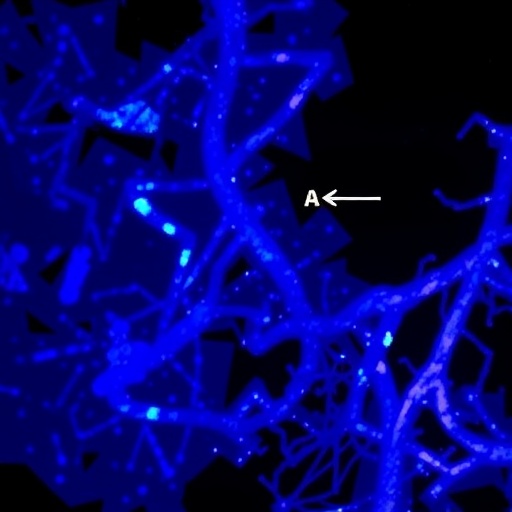In a remarkable advancement in the field of hematology and cancer biology, researchers have uncovered a critical role played by systemic inflammation driven by the NLRP3 inflammasome in regulating the progression of myeloproliferative neoplasms (MPNs) harboring the JAK2V617F mutation. This new understanding links innate immune signaling pathways directly to the pathogenesis of these debilitating blood disorders, opening promising avenues for therapeutic intervention.
Myeloproliferative neoplasms are a group of clonal blood diseases characterized by the excessive production of mature myeloid cells, often leading to complications including thrombosis, bone marrow fibrosis, and transformation to acute leukemia. The JAK2V617F mutation is a well-established oncogenic driver found in the majority of MPN patients, but how this genetic lesion cooperates with the host’s inflammatory milieu to influence disease evolution has remained elusive until now.
The study conducted by Koerber et al., published in Nature Communications, delves deeply into the molecular crosstalk between mutated hematopoietic cells and systemic inflammation orchestrated by the NLRP3 inflammasome, a cytosolic multiprotein complex known for its central role in innate immunity and production of pro-inflammatory cytokines such as IL-1β and IL-18. By employing genetically engineered mouse models combined with patient-derived samples, the research team meticulously dissected the impact of NLRP3 activation on disease burden and progression.
Remarkably, their findings indicate that the presence of the JAK2V617F mutation alone is insufficient to recapitulate the full spectrum of MPN pathology unless accompanied by robust systemic inflammation mediated by NLRP3. In mice genetically deficient in Nlrp3, the hallmark features of MPN such as splenomegaly, aberrant myelopoiesis, and fibrotic transformation were significantly attenuated. This suggests a model in which the inflammasome acts as a critical amplifier of oncogenic JAK2 signaling, tipping the balance towards malignant expansion and pathological remodeling of the bone marrow microenvironment.
Delving into the mechanistic layers, the researchers uncovered that NLRP3 activation leads to caspase-1-dependent processing of inflammatory cytokines, which in turn sustain a pro-inflammatory niche. This environment facilitates the expansion and survival of JAK2V617F mutant clones, potentially by promoting signaling pathways that prevent apoptosis and augment proliferation. Intriguingly, the study also observed increased pyroptotic cell death in non-mutant hematopoietic cells, likely contributing to selective advantage of mutant clones by reducing competition.
One of the most compelling aspects of this research is the therapeutic implication that targeting the NLRP3 inflammasome could serve as a novel strategy to modulate the course of MPNs. The authors tested pharmacologic inhibitors of NLRP3 in their murine models and found a marked reduction in disease phenotypes, including normalization of blood counts and reduction in splenic and marrow fibrosis. These results underscore the inflammasome not just as a biomarker of disease activity, but as a viable molecular target.
Moreover, the study revealed that the NLRP3 inflammasome contributes to systemic symptoms observed in MPN patients, such as fatigue, fever, and weight loss, collectively known as “constitutional symptoms.” By controlling systemic levels of IL-1β and IL-18, NLRP3 activation may be driving chronic inflammation that extends beyond the bone marrow, affecting multiple physiological systems. This insight opens the possibility that inflammasome inhibition could ameliorate both hematologic abnormalities and debilitating symptomatic burdens simultaneously.
Investigations into human patient samples corroborated the murine data, with elevated expression of NLRP3 pathway components detected in peripheral blood cells of JAK2V617F-positive MPN patients compared to healthy controls. Correlation analyses further linked inflammasome activation levels with disease severity and symptom scores, lending clinical relevance to the experimental findings.
The study’s authors emphasize that this paradigm shift redefines inflammation in MPN from a mere epiphenomenon to a central pathogenic driver. By linking mutational events with innate immune pathways, the research bridges oncology and immunology, highlighting the complexity of tumor-host interactions. Such insights can revolutionize how clinicians approach MPN treatment, potentially combining targeted kinase inhibitors with anti-inflammatory agents for synergistic effects.
This integrative perspective also provokes questions about the role of environmental and lifestyle factors that influence systemic inflammation in MPN risk and progression. Could chronic low-grade inflammation from infections, metabolic dysregulation, or other comorbidities prime the inflammasome, thereby accelerating disease emergence or relapse? Such considerations extend the implications of the work beyond molecular biology into personalized medicine and disease prevention.
While the precise triggers initiating NLRP3 activation in the context of JAK2-mutant hematopoiesis remain to be fully elucidated, the study hints at roles for oxidative stress, mitochondrial dysfunction, and danger-associated molecular patterns (DAMPs) released in the tumor microenvironment. Further dissection of these upstream signals promises to not only advance fundamental understanding but also identify additional drug targets.
As the scientific community digests these compelling findings, future research will likely explore inflammasome-targeted therapies in clinical trials, assessing efficacy, safety, and impact on quality of life. Given the chronic and often progressive nature of MPNs, strategies that can sustainably modulate inflammatory circuits without compromising host defense will be paramount.
This breakthrough underscores the importance of cross-disciplinary research that integrates immunology, genetics, and hematology to unravel the complexities of cancer biology. The paradigm emerging from Koerber et al.’s work positions the NLRP3 inflammasome as a master regulator connecting oncogenic mutation to microenvironmental inflammation, a nexus with profound therapeutic potential.
In conclusion, by uncovering the indispensable role of NLRP3-induced systemic inflammation in governing the fate of JAK2V617F mutant myeloproliferative neoplasms, this study not only advances our understanding of MPN pathophysiology but also paves the way for innovative treatment paradigms aiming to transform patient outcomes. As we venture further into precision medicine, targeting inflammation may prove as crucial as targeting oncogenic drivers themselves.
Subject of Research: The role of NLRP3 inflammasome-driven systemic inflammation in regulating the development and progression of JAK2V617F mutant myeloproliferative neoplasms.
Article Title: NLRP3-induced systemic inflammation controls the development of JAK2V617F mutant myeloproliferative neoplasms.
Article References:
Koerber, RM., Krollmann, C., Cieslak, K. et al. NLRP3-induced systemic inflammation controls the development of JAK2V617F mutant myeloproliferative neoplasms. Nat Commun 16, 10591 (2025). https://doi.org/10.1038/s41467-025-65673-4
Image Credits: AI Generated




